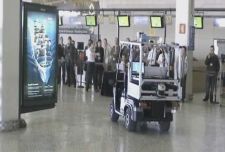Apr 27 2010
Using robotic systems to detect stationary and moving objects remains a challenge for building superior surveillance systems.
 Demonstration of a Robotic Buggy at Faro Airport
Demonstration of a Robotic Buggy at Faro Airport
Now, researchers from Canada, Israel and EU countries have developed a new technology called the 3D LIMS (3D LIDAR Imaging and Measurement System). This technology uses light beams to detect the location of an object.
Majority of LIDAR (Light Detection and Ranging) systems utilize a one-step process to locate the objects. These systems scan the area and measure the time delay between pulse transmission and signal detection. The 3D LIMS technology uses one more step before this step, and enhances the current type of LIDAR systems.
Researchers, working on an IRPS project, first used a LIDAR system to build a three-dimensional map of the area. This enabled the system to detect both stationary and moving objects and locate them precisely within millimeters of their exact location.
According to Maurice Heitz, CS Communication & Systèmes’ researcher and IRPS project manager, the 3D LIMS technology utilizes a two-step process that includes calibration and real-time navigation. This technology enables the system to quickly and precisely detect any changes in the surroundings.
Unlike robotic vision systems that are equipped with cameras, the 3D LIMS technology is unaffected by fog, rain and shadows. This technology delivers distance and angular information for each pixel, which makes it ideal for using in any type of environment.
Researchers predict that the 3D LIMS technology could be used for a wide range of applications. For instance, this technology could be used for improving security surveillance, monitoring industrial equipment, and navigating vehicles in airports.
To underline the possibilities of 3D LIMS technology, the IRPS team developed a prototype application and used the 3D LIMS technology to navigate the buggies. Such vehicles may in the future be used for carrying luggage and passengers around the airports.
The 3D LIMS technology was demonstrated at the Faro Airport in Portugal. Before using the robotic application, a three-dimensional image of the airport setting was created. This enabled the system to detect stationary objects such as walls, doors, columns and staircases. The vehicles then utilized LIDAR technology to determine their position and locate obstacles, while travelling through the airport.
Heitz informed that this 3D LIMS technology will assist disabled and elderly persons to navigate around airports. He further added that there is a greater need to implement robotic buggies in airports; however, more technological advances and other safety factors need to be considered before utilizing such technologies. He added that one major hurdle of operating a 3D LIMS system is that it warrants a huge investment, and lots of computer processing power.
However in industrial monitoring and security surveillance fields, the 3D LIMS system could enhance current techniques by instantly detecting any changes in the environment. Commercial application of the 3D LIMS system seems far away. Nevertheless, the project team is seeking support to conduct further research on this technology.
The ICT wing of EU’s Sixth Framework Programme for research funded the IRPS project.
Source: http://cordis.europa.eu/